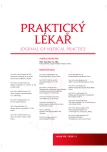Immunity at the most common non-communicable diseases – atherosclerosis and malignant neoplasms
Authors:
P. Šíma 1; V. Bencko 2; L. Vannucci 1
Authors‘ workplace:
Mikrobiologický ústav, v. v. i., AV ČR, Praha, Ředitel: ing. Jiří Hašek, CSc., Laboratoř imunoterapie, Vedoucí: Luca Vannucci, MD, PhD.
1; 1. lékařská fakulta Univerzity Karlovy, Praha, Ústav hygieny a epidemiologie, Přednosta: prof. MUDr. Milan Tuček, CSc.
2
Published in:
Prakt. Lék. 2020; 100(2): 88-91
Category:
Of different specialties
Overview
For decades, cardiovascular diseases and tumours have been among the infamous diseases that most affect people around the world. Both are accompanied by characteristic immune manifestations, which are in principle identical, but differ in a number of essential aspects. Even in the eighties of the last century, the prevailing opinion was that atherosclerosis had multifactorial genesis, i.e. that the causes and development of the pathological process in arteries resulting in the deposition of cholesteric plaque was contributed to several causes of the external and internal environment. External atherogenic causes included high energy intake (excessive consumption of animal fats and carbohydrates), lack of physical activity, smoking and polluted environment, whereas genetically determined defects of lipid metabolism represented endogenous factors. Infectious causes and the role of immunity were practically not considered.
The involvement of immunity in the tumour process has been the subject of reflection even since the early twentieth century. At that time, immunity was only known to be directed against infectious agents, but virtually nothing was known about the structural nature and function of the immune system. Later on, it has been shown that immunity can have a dual function in connection to tumours: it destroys and suppresses tumour cells, but also promotes tumour growth by selecting more viable tumour cells. It is just the participation of the immunity in the tumour process that enables new possibilities for treating tumours by providing biological therapy (immunotherapy).
Keywords:
atherogenesis – trained natural immunity – tertiary lymphoid tissue – immunological surveillance – cancer immunoediting – inflammation
Sources
1. Goldstein JL, Brown MS. A century of cholesterol and coronaries: from plaques to genes to statins. Cell 2015; 161(1): 161–172.
2. Balkwill F, Mantovani A. Inflammation and cancer: back to Virchow? Lancet 2001; 357(9265): 539–545.
3. Rosenfeld ME, Campbell LA. Pathogens and atherosclerosis: update on the potential contribution of multiple infectious organisms to the pathogenesis of atherosclerosis. Thromb Haemost 2011; 106(5): 858–867.
4. Kleindienst R, Xu Q, Willeit J, et al. Immunology of atherosclerosis. Demonstrations of heat shock protein 60 expression and T lymphocytes bearing alpha/beta of gamma/delta receptor in human atherosclerotic lesions. Am J Pathol 1993; 142(6): 1927–1937.
5. Xu Q, Kiechl M, Mayr B, et al. Association of serum antibodies to heat shock protein 65 with carotid atherosclerosis: clinical signifikance determined in a follow-up study. Circulation 1999; 100(11): 1169–1174.
6. Pepys MB, Hirschfield GM. C-reactive protein: a critical update. J Clin Invest 2003; 111(12): 1805–1812.
7. Netea MG, Joosten LAB, Latz E, et al. Trained immunity: a program of innate immune memory in health and disease. Science 2016; 352(6284): aaf1098.
8. Šíma P, Turek B, Bencko V. Ateroskleróza a imunita. Arterie jako terciární lymfoidní orgán? Prakt. Lék. 2018(2): 65–68.
9. Bekkering S, Joosten LA, van der Meer JW, et al. Trained innate immunity and atherosclerosis. Curr Opin Lipidol 2013; 24(6): 487–492.
10. Bekkering S, Quintin J, Joosten LA, et al. Oxidized low-density lipoprotein induces long-term proinflammatory cytokine production and foam cell formation via epigenetic reprogramming of monocytes, Arterioscler Thromb Vasc Biol 2014; 34(8): 1731–1738.
11. Akhavanpoor M, Gleissner CA, Akhavanpoor H, et al. Adventitial tertiary lymphoid organ classification in human atherosclerosis. Cardiovasc Pathol 2018; 32 : 8–14.
12. Yin C, Mohanta SK, Srikakulapu P, et al. Artery tertiary lymphoid organs: powerhouses of atherosclerosis immunity. Front Immunol 2016; 7 : 387.
13. Ehrlich P. Ueber den jetzigen stand der Karzinomforschung. Ned Tijdschr Geneeskd 1909; 5 : 273–290.
14. Burnet M. Cancer: a biological approach. III. Viruses associated with neoplastic conditions. IV. Practical applications. Br Med J 1957; 1(5022): 841–847.
15. Thomas L. Cellular and humoral aspects of the hypersensitive states. Lawrence H. (ed.). New York: Hoeber-Harper 1959.
16. Finn OJ. Human tumor antigens yesterday, today, and tomorrow. Cancer Immunol Res 2017; 5(5): 347–354.
17. Balkwill F. Mantovani A. Inflammation and cancer: back to Virchow? Lancet 2001; 357(9255): 539–545.
18. Vesely MD, Kershaw MH, Schreiber RD, Smyth MJ. Natural innate and adaptive immunity to cancer. Annu Rev Immunol 2011; 29 : 235–271.
19. Zamarron BF, Chen W. Dual roles of immune cells and their factors in cancer development. Int J Biol Sci 2011; 7(5): 651–658.
20. Dunn GP, Bruce AT, Ikeda H, et al. Cancer immunoediting: from immunosurveillance to tumor escape. Nat Immunol 2002; 3(11): 991–998.
21. Dunn GP, Old LJ, Schreiber RD. The immunobiology review of cancer immunosurveillance and immunoediting. Immunity 2004; 21(2): 137–148.
22. Kim R, Emi M, Tanabe K. Cancer immunoediting from immune surveillance to immune escape. Immunology 2007; 121(1): 1–14.
23. Garrido F, Romero I, Aptsiauri N, Garcia-Lora AM. Generation of MHC class I diversity in primary tumors and selection of the malignant phenotype. Int J Cancer 2016; 138(2): 271–280.
24. Mooradian MJ, Sullivan RJ. Immunomodulatory effects of current cancer treatment and the consequences for follow-up immunotherapeutics. Future Oncol 2017; 13(18): 1649–1663.
25. Koo SL, Wang WW, Toh HC. Cancer immunotherapy – the target is precisely on the cancer and also not. Ann Acad Med Singapore 2018; 47(9): 381–387.
26. van den Bulk J, Verdegaal EM, de Miranda NF. Cancer immunotherapy: broadening the scope of targetable tumours. Open Biol 2018; 8(6): pii: 180037.
Labels
General practitioner for children and adolescents General practitioner for adultsArticle was published in
General Practitioner

2020 Issue 2
Most read in this issue
- General overview of percutaneous endoscopic gastrostomy
- Anxiety of pregnant women – importance, risk factors, consequences
- Standard, neglected and new information about compression therapy with bandages
- Thyroid cancers
